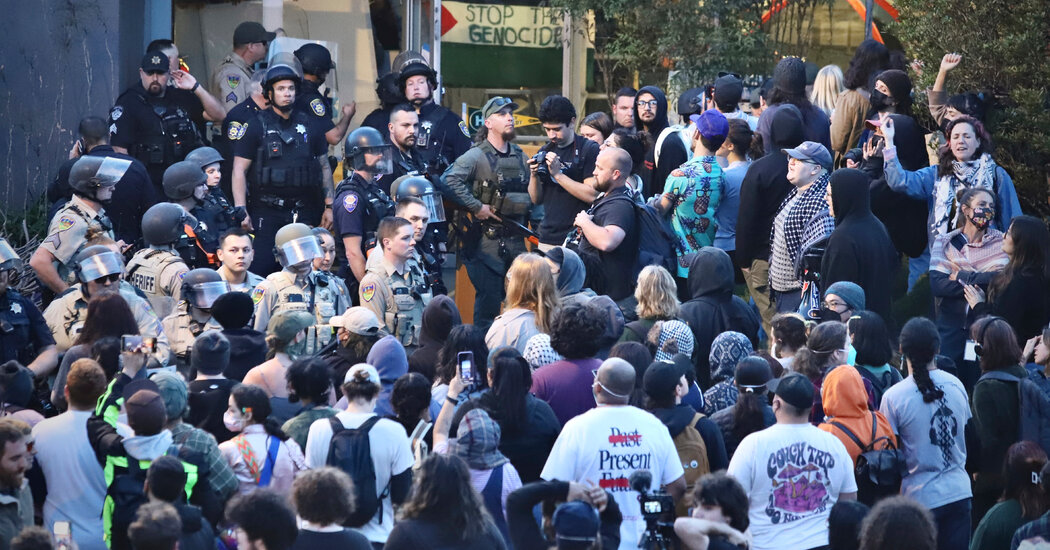When university administrators across the nation worry about the potential fallout from campus protests, they may have Siemens Hall in mind.
The building, at California State Polytechnic University, Humboldt, includes the campus president’s office and has been occupied for a week by pro-Palestinian protesters who barricaded themselves inside and fought off an early attempt by the police to remove them. Protesters have since tagged walls and renamed it “Intifada Hall” by ripping off most of the signage on the brick exterior.
Inside, they painted graffiti messages like “Time 2 Free Gaza,” “Pigs Not Allowed,” and “Land Back,” according to a video posted by the local news site Redheaded Blackbelt. They occupied and defaced the office of the president, Tom Jackson Jr., spraying “Blood On Your Hands” across one framed wall hanging and “I Will Live Free or Die Trying” on his door.
The school, more than 275 miles north of San Francisco, among the ancient coastal redwoods dripping with fog mist, is the site of the most entrenched of the campus protests across the country. It has gone well beyond the encampments on student quads elsewhere; at Cal Poly Humboldt, protesters took over the power center of the campus and have rejected increasingly desperate entreaties from officials for them to vacate the premises.
The university has shut down the entire campus, first for a couple days, then a week and now through May 10, one day before its scheduled commencement. After the Siemens Hall takeover, protesters set up dozens of tents on patches of grass around the hall, and demonstrators took over a second building to use its bathrooms and hold meetings. University officials estimate the damage to be in the millions of dollars.
To those outside Northern California, the show of force at Cal Poly Humboldt, in the college town of Arcata, has been a surprising turn in a region more typically associated with a hippie pacifism and marijuana farms. But beneath the good-vibes image, locals say, a culture of protest and resentment toward authority has percolated at the 6,000-student campus.
“Because of the long history of activism, we recognize that putting a tent out in front of the building may not be as effective of a statement for a student protest,” said Anthony Silvaggio, who is a professor and the chair of the school’s sociology department and was a student at the university in the 1990s.
The majestic redwoods in the region draw tourists from across the world; nearby, visitors can drive through a tree with a 21-foot diameter. The forests also have satisfied the thirst for lumber in the growing West as far back as the early Gold Rush days when San Francisco became a boomtown.
The natural beauty and the timber industry have long been at odds, however. The region was an early battleground in the “timber wars,” in which environmentalists fought against logging companies to prevent the destruction of old growth forests across the Pacific Northwest in the 1980s and 1990s. Perhaps the most famous protest of that era occurred in Humboldt County, where the activist Julia Butterfly Hill lived for 738 days in a California redwood that she named Luna.
Cal Poly Humboldt had modest beginnings, opening in 1914 as the Humboldt State Normal School to educate schoolteachers, starting with a graduating class of 15 women. Its academic mission expanded over the next century to offer a breadth of subjects, including forestry. (The school mascot is the Lumberjacks).
The campus is isolated from most of California, requiring at least a five-hour drive to reach San Francisco or Sacramento. Only 2 percent of undergraduates are Jewish, according to Hillel International, and the campus does not seem to have an active Jewish organization.
Pro-Palestinian protesters have made several demands since taking over Siemens Hall on April 22, including that the school disclose its holdings with Israel, divest from companies profiting from military action in Gaza, cut ties with Israeli universities and that charges against three students who were arrested the first night be dropped. They also want the university to call for a cease-fire in the Israel-Hamas war. More than 34,000 Palestinians have been killed in the conflict, according to the Gaza health ministry.
Cal Poly Humboldt leaders replied point by point, disclosing the school’s holdings and collaborations with Israel in an attempt “to make a good faith effort to respond.” By Friday, however, administrators had seemingly had enough. They told building occupiers that they had a brief “opportunity to leave with a guarantee of no immediate arrest.” A spokeswoman for the university said several protesters left the building, but protesters disputed that there had been any desertion in their ranks.
On Sunday night, the president’s team again asked them to “leave the campus peacefully now,” but this time with no offer of immunity.
The university said in a statement that the protest had “nothing to do with free speech or freedom of inquiry” and called the protests “lawless behavior” that harmed students, damaged the school’s reputation and “drained resources from the accomplishment of our core educational purpose.”
Demonstrators see it differently.
“The graffiti, the destruction of property, all of that is a poetic symbolism to me, because the ultimate overall point is that people are more valuable than property,” said Cozy Hunter, 32, a graduate student in social psychology academic research.
In 2019, Mr. Jackson became the president at Humboldt after having served the same role at Black Hills State University in South Dakota. Mr. Jackson, a veteran of the U.S. Coast Guard Reserve, was instrumental in transforming the campus into a polytechnic university, one of three in California, that places an added emphasis on STEM disciplines. The revamp came with $458 million from the state, a welcome infusion of cash at a school that was at risk of closure as enrollment declined over the years.
“I’m an engineer, so when he brought in the money and turned this into a Cal Poly, that was really cool because we had done cuts for years,” Jim Graham, a professor of geospatial science, said.
While previous campus presidents engaged with student protesters and generally allowed sit-ins, Mr. Jackson was more distant and took a harder-line approach, Mr. Graham said.
In November, after the university discovered that some students were living in their vehicles on campus because they could not afford housing, the school ordered them to move out or face disciplinary action. In 2022, Mr. Jackson apologized for comments he made during a welcome address that some saw as an attempt to hide reports of sexual assault in the campus community.
“That was sort of the beginning of him totally disappearing,” said Cindy Moyer, the chair of the university’s Department of Dance, Music and Theater. “He does not appear to take controversy well.”
Mr. Jackson was unavailable for comment, according to a spokeswoman. But last Friday, he told the local Times-Standard newspaper that the protesters were “criminals” and did not rule out sending in police at some point. “Everything is on the table,” he said.
Bob Ornelas, who is a former mayor of Arcata and a graduate of the university, said that the response to the protest in the community, which is largely liberal, has been “a really mixed bag.” Mr. Ornelas, 70, said many residents are sympathetic but also anxious about the effects on local business and concerned about potential divisiveness in the community.
Since the protests started, the 32-room Hotel Arcata has lost about $1,000 per day to cancellations, whether for special events or rooms for the families of graduates, said Sherrie Potter, 55, the hotel’s general manager. The university has not canceled commencement, though many wonder how it will still take place.
“I understand where they’re coming from, I do,” Ms. Potter said of the protesters. “But I’m torn. I also see how this is hurting the college and the businesses around it, including our own.”
Protesters said they initially wanted to stage a sit-in and bring their concerns directly to administrators. When the local police showed up in riot gear, they feared for their safety, and began barricading themselves inside, they said. Most refused to give their names because they feared retribution from the university and said they did not want to be doxxed.
“The rate of acceleration, and the escalation, was so shockingly high,” said Rouhollah Aghasaleh, an assistant professor in education who has tried to facilitate communication between protesters and the university.
Over the weekend, as the likelihood of a police incursion increased, protesters beefed up the barricades that blocked off their encampment with chain-link fences, rows of chairs and large sheets of glass. In a nod to the past environmental protests in the area, they installed a “tree sit” about 60 feet up in a redwood near the quad, with a wooden platform that had the phrases “Free Gaza” and “End Empire.” The protester manning the perch — who would not give a name, other than “Ripples” — settled in with a mattress pad, sleeping bag and crank radio.
“A tree sitter actually indicates that there’s a desire for a much longer occupation,” Ms. Hunter, the graduate student, said. “Because a tree sitter — especially in this region after Julia Butterfly Hill — is just like, ‘Oh, I’m down to sit for Palestine until there is complete U.S. divestment.’ That’s essentially what that move means.”
Jose Quezada contributed reporting from Arcata, Calif., and Shawn Hubler contributed from Sacramento.



